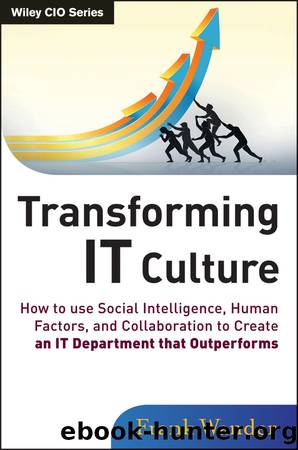Transforming IT Culture by Frank Wander

Author:Frank Wander
Language: eng
Format: epub
Publisher: Wiley
Published: 2013-01-31T16:00:00+00:00
Dysfunctional Organizations Have Less Time for Compassion
Beware the barrenness of a busy life.
âSocrates
Organizations that are suffering from dysfunction are caught in a downward spiral. As dysfunction increases, work slows, and as work slows, pressure increases. Deadlines fall behind, tasks build up, and people need more emotional support than ever. But research shows very clearly that people in a rush are least likely to help.
In a study on this topic, John M. Darley and C. Daniel Batson designed an experiment at Princeton Theological Seminary that used 67 seminary students as subjects who were told they were needed to do a reading.5 When the subjects arrived at the location they were instructed to come to, they were asked to practice some scripted text and then told to proceed to another building where they would be recorded. Interestingly, half the students were told they would be doing a reading on the parable of the Good Samaritan and the other half something else. Along the way, they passed a man slumped in a doorway, in obvious need of help. The purpose of the study: Find out how many would stop.
To understand the impact of pressure, a time variable was added, and the students were broken into three groups: High Hurry (youâre late, go right now); Intermediate Hurry (they are ready for you but no need to rush); and, last, Low Hurry (they arenât ready; you can take your time).
The research showed that 63 percent of the Low Hurry group stopped, followed by 45 percent of the Intermediate Hurry, and only 10 percent of the High Hurry subjects. Whether they were giving a talk on the Good Samaritan or not had no impact on their helping behavior. The time pressure led them to behave selfishly.
The lesson for work is clear: There are always pressures, so modeling the right behavior for your teams or coworkers will greatly increase the bias to help. More important, designing a culture that is productive, collaborative, supportive, and creative greatly improves the flow of work, reducing the incidence of high-hurry, struggling projects. Also, building a culture where helping others, showing empathy, and demonstrating compassion is both valued and noted will overcome this negative bias, especially in IT, where there is always more work than time. The toxicity of selfishness is always prevalent in dysfunctional organizations, not in emotionally healthy ones.
Download
This site does not store any files on its server. We only index and link to content provided by other sites. Please contact the content providers to delete copyright contents if any and email us, we'll remove relevant links or contents immediately.
Storytelling for dummies by Andrea Fontana(1494)
Effortless by Greg McKeown(1434)
The Practice by Seth Godin(1406)
Mastering Blockchain by Lorne Lantz(1394)
Blockchain Quick Reference by Paul Valencourt & Samanyu Chopra & Brenn Hill(1152)
Mastering Blockchain by Lorne Lantz & Daniel Cawrey(909)
The wind in the willows by Kenneth Grahame(853)
How to Lead by David M. Rubenstein(826)
The Ape in the Corner Office by Richard Conniff(792)
Handbook of Big Data Analytics by Unknown(713)
Social Media Engagement For Dummies by Aliza Sherman(711)
Taking Care of Yourself (HBR Working Parents Series) by Harvard Business Review(698)
Getting Started with Data: The first book you should read to successfully get along with data. by Menegatti Gabriel & Team Simbiose Ventures(695)
FunRetrospectives: activities and ideas for making agile retrospectives more engaging by Paulo Caroli & Tainã Caetano Coimbra(693)
Business Storytelling For Dummies by Unknown(670)
Evernote for Self Publishing: How to Write Your Book in Evernote from Start to Finish by Jose John(668)
Help! My Facebook Ads Suck-- by M. D. Cooper & Jill Cooper(654)
A Leader Listens by Ajay Banga(640)
Genius by Choice: Your unconventional A–Z handbook to enhance your learning process by Remondino Giulia S(640)
